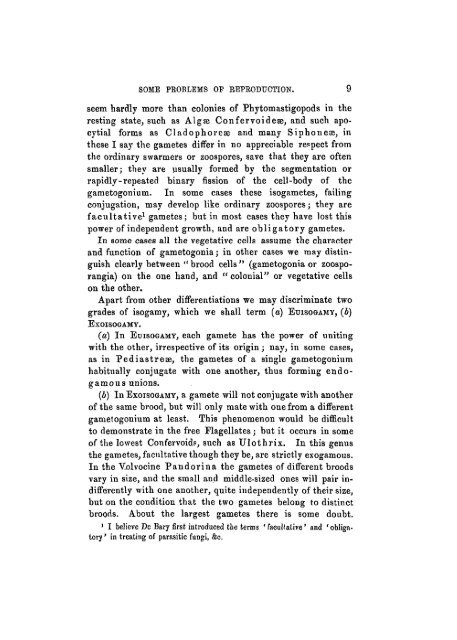Some Problems of Reproduction: a Comparative Study of ...
Some Problems of Reproduction: a Comparative Study of ...
Some Problems of Reproduction: a Comparative Study of ...
You also want an ePaper? Increase the reach of your titles
YUMPU automatically turns print PDFs into web optimized ePapers that Google loves.
SOME PROBLEMS OP REPRODUCTION. 9<br />
seem hardly more than colonies <strong>of</strong> Phytomastigopods in the<br />
resting state, such as Aigse Confervoidese, and such apocytial<br />
forms as Cladophorese and many Siphonese, in<br />
these I say the gametes differ in no appreciable respect from<br />
the ordinary swarmers or zoospores, save that they are <strong>of</strong>ten<br />
smaller; they are usually formed by the segmentation or<br />
rapidly-repeated binary fission <strong>of</strong> the cell-body <strong>of</strong> the<br />
gametogonium. In some cases these isogametes, failing<br />
conjugation, may develop like ordinary zoospores; they are<br />
facultative 1 gametes; but in most cases they have lost this<br />
power <strong>of</strong> independent growth, and are obligatory gametes.<br />
In some cases all the vegetative cells assume the character<br />
and function <strong>of</strong> gametogonia; in other cases we may distinguish<br />
clearly between " brood cells " (gametogonia or zoosporangia)<br />
on the one hand, and " colonial" or vegetative cells<br />
on the other.<br />
Apart from other differentiations we may discriminate two<br />
grades <strong>of</strong> isogamy, which we shall term (a) EUISOGAMY, (b)<br />
ExOISOGAMY.<br />
(a) In EUISOGAMY, each gamete has the power <strong>of</strong> uniting<br />
with the other, irrespective <strong>of</strong> its origin ; nay, in some cases,<br />
as in Pediastrese, the gametes <strong>of</strong> a single gametogonium<br />
habitually conjugate with one another, thus forming endogatnous<br />
unions.<br />
(b) In EXOISOGAMY, a gamete will not conjugate with another<br />
<strong>of</strong> the same brood, but will only mate with one from a different<br />
gametogonium at least. This phenomenon would be difficult<br />
to demonstrate in the free Flagellates; but it occurs in some<br />
<strong>of</strong> the lowest Confervoidp, such as Ulothrix. In this genus<br />
the gametes, facultative though they be, are strictly exogamous.<br />
In the Vjjlvocine Pandorina the gametes <strong>of</strong> different broods<br />
vary in size, and the small and middle-sized ones will pair indifferently<br />
with one another, quite independently <strong>of</strong> their size,<br />
but on the condition that the two gametes belong to distinct<br />
broods. About the largest gametes there is some doubt.<br />
1 I believe De Bary first introduced tbe terms ' facullative' and 'obligatory<br />
' in treating <strong>of</strong> parasitic fungi, &o.

















